Show
→ summary
→ detailed version

Keywood, ruler of Keydom, has set up a land registry. Part of the land of
Keydom has been divided into plots. A record of the ownerhip of these
plots will be kept at the registry, which will also specify the type of
crops that can be produced in each of the designated plots.
Each plot of land has been allocated a unique reference for identification
and a title deed for each plot is to be issued by the registry. The title deed
shows the plot reference and a symbol identifying the type of crop
that can be produced in that plot. In the game the title deeds are
represented by the 'field tiles' (so called because the plots of land are
field sized and the fields are depicted on the tiles). Usually six field tiles
will be available from the registry at any one time. The crops produced
in the fields are represented in the game by the wooden crop counters.
Each player is one of the citizens of Keydom. On their turn, players are
offered the opportunity to bid for the field tiles as they become available
from the registry. Bids are made with the crop counters that have
been generated from the player's existing fields. When a player bids
for a field tile they place both the field tile and their bid (in crop
counters) into their store. Whilst the field tile remains in a store, the other
players may buy the field tiles from the store's owner. They do this by
matching the number and type of crop counters bid by the store's
owner, which they must then pay to the store's owner. If the other
players choose not to buy the field tile then the store's owner pays the
crop counters from their store into the general stock and places the field
tile onto their country board. In this way players can assemble large land
holdings, which are then more efficient to harvest.
Keywood is keen to facilitate the rationalisation of the land holdings in
this way and therefore allows the players to retain the crop counters
that they have received in payment from the other players, even though
the field tiles were not yet theirs to sell. Keywood allows this as he
knows that in due course he will receive most of those crops in
payment from the players when they acquire further field tiles (later in the
game). Keywood is however keen to maintain a competitive economy
within Keydom and to ensure that no single land holding that is created is
too large. He has therefore devised a (scoring) system to reward the
player achieving the two largest and most balanced (in size) land holdings.
Each player has a team of six farmhands to assist them in their
efforts. When a player becomes more established they may also be
able to enlist the assistance of some of the townsfolk such as the lawyer
or the bailiff. A number of events will also affect all of the players, helping
or hindering their attempts to enlarge and consolidate their land holdings.
The object of the game is to score the most points. Players score
points by placing tiles on their own country board. One point is scored
for each field tile in the player's largest group of connected field tiles
and two points for each tile in their second largest connected group.
Points are also scored for the worker tiles a player places on their country
board. The number of points scored for each worker is equal to the
number on the worker tile. Worker tiles do not count as connecting tiles
when calculating the largest group of tiles. When played, a worker
enables a player to take a special action. Each player has their own
team of six workers, known as farmhands. There are also six
townsfolk who can be acquired by any of the players.
There are usually six field tiles available at any time from the
registry. On thir turn a player may bid for up to two of those tiles using
crop counters. The field tile being bid for and the bid in crop counters
are placed in the player's store. On their turn the other players may
match the store owner's bid in both the number and type of crop
counters. If they choose to do so, then they place the field tile on their
country board and pay the crop counters to the store's owner. If no
other player has matched the store owner's bid, then on their next turn
the store's owner may place the field tile(s) from their store onto their
country board and pay their bid in crop counters to the general stock.
When deciding how much to bid for a field tile, players will need to consider
how important the field tile is to them and whether other players are likely
to bid for the tile. It is usually beneficial for a player to place field
tiles into their store as that player will either obtain the field tile or receive
additional crop counters.
When played, a worker tile must be adjacent to at least the number of
field tiles as the number on the worker tile. A worker tile cannot be
adjacent to another worker tile. If a player obtains a field tile for a space
where they have already placed a worker tile, they must remove the
worker tile. However, if the worker tile can be replaced immediately
(next to the required number of field tiles), then the player can benefit
from the worker's ability again. Getting these extra benefits is one of
the keys to doing well in the game.
Players have two actions per turn. There are four possible actions.
Each action can only be performed once per turn. As described above,
the actions include placing field tiles from the stores onto their country
board - action (c), placing field tiles from the registry into their store -
action (d) and placing a worker tile onto their country board - action (b).
Action (c) cannot be performed after action (d). A player may also harvest
crops by turning over some unharvested field tiles on their
country board - action (a).
Field tiles taken from the registry are replaced immediately with field tiles
from the bag. The bag also contains a number of event tiles. The event
tiles when drawn affect all of the players, not just the player who drew
the event tile. When the tenth event tile is drawn the game ends after two
further rounds have been played.
One point is also awarded to the players who have the most of each
of the types of crop counters at the end of the game. No points are
awarded for ties. Points are tallied using the scoring track on the town
board. The player with the most points is the winner.

- 4 country boards, each containing 56 uniquely referenced hex shaped field spaces.
-
60 wooden crop counters in total, 12 each in brown (hops), green (vegetables), orange
(cider apples), red (barrels of wine) and yellow (wheat).
-
6 townsfolk (worker) tiles numbered 4 or 5.
-
24 farmhand (worker) tiles, 6 in each of the four player colours, numbered 1, 2, or 3.
- 14 event tiles.
-
The cloth bag is used in the set up stage and then to hold the field tiles and the event
tiles during the game. It is also used to identify whose turn it is and is passed to the next player
at the end of each player's turn.
-
1 town board that contains:
- 6 spaces on which to place the townsfolk tiles.
- 10 spaces on which to place the event tiles when these are drawn from the bag.
-
6 spaces in the land registry on which to place the field tiles that are currently available.
It is recommended that these are maintained in alpha numeric order throughout the game for ease
of reference.
- Scoring track, used at the end of the game only.
- 4 screens.
-
4 turn option and scoring cards. The cards
list the turn options and the different ways of scoring points at the end of the game.
- 4 store cards.
- 56 double sided hex shaped field tiles each representing a different plot of land.
Place the town board in the middle of the playing area.
Each player receives a screen, store card, turn option card and a set of 6
farmhand tiles in their chosen colour, plus one of the four country boards.
Each player places their store card in front of their country board, their country
board as close to the town board as possible, and their
6 farmhand tiles next to their country board mat, so that they can be seen by all
the players. Only the resources (see below) are placed behind a player's screen.
Each player takes a crop counter which is the same colour as their player
colour and places this in the cloth bag. The player to the left of the player who
is reading these rules draws one crop counter from the bag. The player whose
player colour is drawn chooses the start player.
Place the 6 townsfolk tiles on appropriate spaces on the town board.
There are four pairs of field tiles that have coloured alpha numeric location
references. Place one tile of each colour in the cloth bag. Each player then
draws one tile from the bag. They then take the second tile of the same colour.
These two tiles are that player's starting tiles. Each player places both of these
tiles onto their country board in the spaces with the corresponding references.
In the two player game take six crop counters, 4 different colours and 2 of the
fifth colour. Each player takes three crop counters, including one each of the
fifth colour. In the three player game place nine crop counters in the bag (two
each of four of the colours and one of the fifth colour). Each player secretly
draws three crop counters. In the four player game place twelve crop counters
in the bag (three each of two of the colours and two each of the remaining three
colours). Again each player secretly draws three crop counters from the bag.
The remaining crop counters are placed together by the side of the player
board. These resources form the general stock.
Next, place all of the remaining field tiles in the bag. Draw 6 field tiles from
the bag and place these with the large crop symbol side face up onto the six
land registry spaces on the town board.
In the two player game place all 14 event tiles into the bag. In the three or
four player game remove two of the event tiles (wihout revealing which ones)
from the game and put these to one side and place the remaining 12 event
tiles into the bag.
Allow room for a fallow field area by the side of the playing area. Fallow fields
are fields represented by field tiles which have been removed from the game.
These are placed in an area at the edge of the playing surface so that players
can identify which field tiles are no longer in the game.
You are now ready to start the game.
Play starts with the start player and then continues in clockwise order.
Players take turns in clockwise order.
On their turn a player may perform up to two of the following four actions:
Each turn a player can choose up to two of the four different actions.
- Harvest crops.
- Play or remove a worker tile.
- Transfer field tiles from the stores onto their player mat.
- Place field tiles from the registry into their store.
Each of the four actions may only be performed once. They may be performed in
any order except that if action (c) is chosen it cannot be performed after action (d).
Action (c) cannot be chosen after action (d).
After completing their actions, a player should pass the cloth bag (and
contents) to the player on their left to show that they have finished their turn.
A player passes the cloth bag when their turn is finished.
The turn actions are explained in more detail below:
When a field tile is placed on a player's country board in action (d), the tile is
placed with the large crop symbol face up in order to indicate that the field may
be harvested. On the reverse side of the field tile there is a smaller symbol
which identifies the type of crop which has already been harvested from that field.
When a field tile is harvested it is turned over from its original 'unharvested' side
(showing the large crop symbol) to the harvested side (with the small crop symbol).
When harvested the field tile is turned over to indicate it has been harvested.
A player may harvest any number of unharvested fields from one connected
group of field tiles on their own country board. It does not matter if the connected
group of field tiles also includes harvested field tiles, although the player cannot
get another crop counter from the tiles that have the harvested side face up. The
unharvested tiles in the connected group do not need to be adjacent to each other.
Worker tiles do not connect field tiles for harvesting (or any other) purposes.
Harvest any number of unharvested field tiles in a connected group.
A player takes the crop counters of the types indicated by the field tiles that
have been harvested from the general stock. If there are no crop counters of
the correct type remaining in the general stock, then a player may choose a
different type of crop counter instead (if available). In these circumstances the
field tile is still turned over to its harvested side. The player should place the
crop counters behind their screen.
When harvesting take crop counters from the general stock.
A player may play a worker tile onto their country board or remove a worker tile
from their country board. The worker tile can be either one of a player's own
six farmhand tiles or one of the six unique towsfolk tiles from the town board.
Play either a farm worker tile or a townsfolk tile.
When a player plays a worker tile onto their country board, the worker tile must be
adjacent to at least the number of (harvested or unharvested) field tiles as the number
on the worker tile and the worker tile must not be adjacent to another worker tile.
When played, a worker tile must be adjacent to at least the number of field tiles as the
number on the tile. A worker tile must not be adjacent to another worker tile.
When a player removes a worker tile from their country board, the tile is placed
back by the side of their country board if it is a farmhand tile or back on the
town board if it is a townsfolk tile.
A player cannot remove and play a worker tile in one turn. This is because
playing and removing a worker tile are alternatives under action (b) and action
(b) can only be chosen once in each player's turn.
Worker tiles can be played into an empty space or to replace a worker tile of a
lower value.
A worker tile can either be played into an empty space or onto a space
occupied by another worker tile with a lower value. If a player is replacing a
farmhand tile, then the replaced tile is placed back with the player's other unplayed
farmhand tiles (if any) or, if it is a townsfolk tile, back on the town board.
In both cases the replaced tile can then be played again in the normal way
later in the game. E.g. the supervisor tile can be played over the apprentice
tile, the casual worker tile, the unskilled worker tile or the labourer tile.
A player may place one or two field tiles from any of the stores onto their
country board. The field tiles may be from the player's own store or from an
opponent's store. The field tiles may be taken from different stores.
A player may place one or two field tiles from any of the stores onto their country board.
If a player places a field tile from their own store onto their country board, then
they place the accompanying crop counters from their store into the general stock.
If the field tile is taken from a player's own store, place the crop counters in general stock.
If a player takes a field tile that is in another players' store, then they must
match from their own supply of crop counters, the number and type of the crop
counters that the store's owner has placed next to the field tile and pay these
crop counters to the store owner. The store owner then places behind their
screen both the crop counters they have received and the crop counters they
originally placed by the field tile in their store.
If the field tile is taken from another players' store, match the number and type of crop
counters and pay to the store owner.
When a field tile is placed onto a player's country board, the player must place
the field tile onto the space with the same alpha numeric reference. The field
tile is placed with the unharvested side face up, so that the side with the large
crop symbol is showing.
Place the field tile on the space with the same alpha numeric reference.
If a player acquires a field tile for a location where they have already placed a
worker tile, then they must replace the worker tile with the field tile. They may,
if possible, immediately reposition the worker tile in a different position and
benefit again from the effects of the worker tile (see also 'worker tiles' section).
Repositioning the worker tile in these circumstances does not count as one of
the player's actions.
If the space is occupied by a worker tile, reposition and reactivate the worker tile or remove the worker tile.
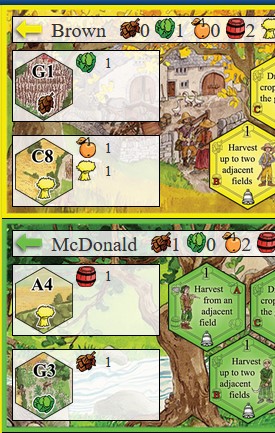 Tiles for sale along with their bids appear on the left side of each player area.
Tiles for sale along with their bids appear on the left side of each player area.
If there is space in their store, a player may place one or two field tiles from the
registry (on the town board) into their store. A player may have a maximum of
two field tiles in their store at any one time.
Place one or two field tiles from the registry to player's own store.
A player places one field tile from the registry into their store at a time. After
they have placed the first field tile into their store they must place a 'bid' next to
the field tile. A bid consists of one or more crop counters. Once the bid has
been placed next to the field tile a player may not change this bid. A player
cannot subsequently redistribute the crop counters between the two tiles in
their store or add or remove crop counters to or from the field tiles in their store.
Place a bid of crop counters next to the field tile.
A player may place a field tile into their store because they want to place the
tile onto their country board on a subsequent turn, or because they want
another player to buy the tile in order to receive some crop counters, or for
both reasons! The number and type of crop counters they place in the store
with the field tile will depend on their objectives.
A field tile in a store cannot be discarded. A field tile will remain in a player's
store until it is moved onto a player's country board under action (d) or until the
end of the game!
After a player has taken a field tile from the registry and placed the field tile into
their store together with their bid in crop counters, they immediately draw a
replacement field tile from the bag. If a field tile is drawn, then the tile is placed
onto the empty space in the registry before the player takes a second field tile
from the registry, takes another action or finishes their turn. Field tiles placed
in the registry are always placed with the unharvested side face up. If an event
tile is drawn, the event is resolved immediately (see 'event tiles' seciton) and
then another tile is drawn from the bag. Therefore, if a player is taking a
second field tile from the registry they will again have six tiles to choose from
(except sometimes in the end game phase).
Immediately draw a replacement tile from the bag. See 'event tiles' if an event tile is drawn.
Players are allowed to feel the bag to estimate how many tiles remain in the bag.
The game ends when the tenth event tile is placed on the town board. The
event on the tenth tile is performed in the same way as the other event tiles.
The game ends when the tenth event tile is placed on the town board.
The player drawing the tenth event tile finishes their turn. All players then have
two further turns, finishing with the player who drew the tenth event tile.
Each player takes two further turns.
During these final two turns, field tiles (if there are any left) are drawn as
normal to replace any field tiles taken from the registry.
Any event tiles that are drawn after the tenth event tile has been placed on the
town board are ignored.
Each player takes a crop counter in the same colour as their player colour and
places this on the zero space of the scoring track on the town board.
Use the scoring track to score at the end of the game.
Each player places their farmhand tiles that they did not place on their country
board to one side in order that they do not get mixed up with the worker tiles
that they did play.
Points are scored in the following four ways and recorded on the scoring track:
Points are scored as follows:
Worker tiles - the numbers on the tiles.
Largest group of field tiles - one point each.
Second largest group of field tiles - two points each.
Crops - one point for the most in each colour.
-
Worker tiles. Each player removes the worker tiles from their country
board. They score the value of the numbers shown on the worker tiles.
-
Largest connected group of field tiles. Each player scores one point
for each tile in their largest connected group of tiles.
-
Second largest connected group. Each player scores two points for
each tile in their second largest connected group.
-
Crop counters. For each of the five crops, the player who has most of
that type of crop counters scores one point, i.e. 5 points are available in total. If
the amounts are equal then neither player gets a point. Only the crop counters
behind a player's screen count. Crop counters on a tile in a store at the end of
the game do not count. Unharvested field tiles do not count.
The player with the highest score is the winner.
The highest score wins!
If two or more players have equal highest number of points the tie is broken in
the following order:
- Player with the most field tiles on their country board.
- Player with the most crop counters behind their screen.
If still level, the game should be replayed to determine the winner.
There are 56 double sided hex shaped field tiles each representing a different
plot of land. Each tile has a unique alpha numeric plot reference. One side also has
a large coloured symbol which indicates the type of crop grown in that plot. The
reverse side has a small symbol to indicate what type of crop has been
harvested from that field. When the large symbol side is face up it indicates
that the field has a crop that can be harvested. Whe the crop has been
harvested the field tile is turned over to the side that depicts a small symbol in
order to show that the field has been harvested.
Each field tile displays a unque reference and a crop symbol.
When harvested, a field generates a crop counter of the same type as the
coloured symbol: hops (brown), vegetables (green), cider apples (orange),
barrels of wine (red) and wheat (yellow). Some of the tiles show the alpha
numeric references in colour, not black only. These tiles are used in the set up
phase of the game.
Field tiles generate crop counters when harvested.
An 'unconnected field tile' is a field tile that is on a player's country board and
that is not adjacent to another field tile. If the field tile is adjacent to a worker
tile but not another field tile, it is still an unconnected field tile. Worker tiles are
never considered to be unconnected tiles, even if they become unconnected.
Unconnected field tiles are field tiles not adjacent to another field tile.
During the game, when a field tile is placed into a new location, the field tile is
always placed with the large crop symbol side face up so it is ready for
harvesting. This applies even if the field tile was previously indicating that it
had been harvested, for example, if the field tile was moved from another
player's country board where the field tile had already been harvested.
Initially field tiles are placed so that the large crop symbol is visible.
If a field tile is acquired for a location on a country board where there is a
worker tile, the worker tile is replaced. If there is another location where the
worker tile can be placed, i.e., where there are the required number of adjacent
field tiles, then the worker tile can be placed there immediately and the
associated action carried out again. If the worker tile can be replaced in a
different position, this does not count as one of the player's two actions, it is a
'bonus' action. If there is not another location where the worker tile can be
placed, then the worker tile is returned to the side of the player's country board
and can be replayed again later in the game in action (b).
If a field tile is acquired and the space is occupied by a worker tile, reposition
and reactivate the worker tile or remove the worker tile.
In the two player game all 14 event tiles are used. In the 3 or 4
player game two tiles are selected at random in the set up
(without revealing which tiles these are) and removed from the
game. The letters on the top of the event tiles are for reference
only, so that the event tiles can easily be found in the rules.
When the tenth event tile is placed on the town board the
end of the game is triggered. See 'end of game' section.
During the game, if a player draws an event tile, it is immediately placed onto
the town board in the next available space. The first event tile drawn in the
game is placed on the number one space, the second event tile drawn
is placed on the number two space, and so on.
If an event tile is drawn, place the tile onto the town board in the next available space.
The seventh event tile is placed on the space with the question mark. When
the seventh event tile is drawn, all players check their country boards to see
how many field tiles and worker tiles they have on their country board. If one
or more players have fewer than seven field and worker tiles on their country
board, then the event tiles on the number one and number two spaces on the
town board are placed back into the cloth bag. All the other event tiles are
moved to the space numbered two less than the space they were on, so that
only the spaces numbered one to five are occupied. This check is repeated
every time an event tile is placed onto the question mark space.
When the seventh event tile is placed, check that all players have at least seven
tiles on their country board. If not replace the first two event tiles into the bag.
In order to avoid endless games online, we have one additional condition: if there are no
field tiles left in the bag, then all seven event tiles will remain on the town board,
even if one or more players do not have the required seven tiles on their country board.
The event tiles affect all players, not just the player who drew the tile. The event
affects the players in clockwise order, starting with the player who drew the tile.
Event tiles affect all of the players.
Note that some events affect 'unconnected' tiles. Unconnected tiles are field tiles
that are not connected to another field tile. A field tile connected to a worker tile
and not another field tile is still considered to be unconnected. Worker tiles are
never considered as unconnected tiles, even if they become unconnected.
If, when drawing a field tile from the bag
as the result of the actions required by
an event tile
a player draws another event tile, they should announce which
event tile it is to the other players and then place the event tile to one side.
Then, after a field tile has been successfully drawn, the event tile(s) that were
placed to one side are placed back into the bag. In the unusual event that
there are no more field tiles in the bag but there are event tiles, then the event
tile(s) are placed on the town board (until there are ten event tiles on the
board) and the event(s) performed in the usual way.
After the completion of an event there will be fewer than six field tiles on the
town board. If an event tile is drawn when filling the empty spaces, then
the
event is actioned
in the normal way.
Each individual event tile is explained in detail in the
Event tile reference.
There are two types of worker tiles. The players' own
farmhand tiles in their player colour, which are
numbered one, two, three, and the townsfolk tiles
that are placed on the town board at the beginning of
the game. The townsfolk tiles are numbered four or five.
The different worker tiles and their values are detailed on page 10.
Each player has the same set of 6 farmhand tiles: apprentice, casual worker,
unskilled worker, labourer, skilled worker and supervisor. A player keeps their
farmhand tiles in front of their screen so that other players can easily see how
many farmhand tiles they have yet to play.
Worker tiles are played onto or removed from a player's country board in turn
action (b). A player's farmhand tiles cannot be played onto another player's
country board.
Each worker tile has a number on it. This number is relevant for two reasons:
Firstly, when a worker tile is played onto a player's country board, the worker
tile must be adjacent to at least the number of field tiles as the number on the
worker tile. This is the only time that the requirement to be adjacent to this
number of field tiles is tested. It does not matter, if later in the game, some or
all of the adjacent field tiles are removed. The field tiles that are adjacent to
the worker tile do not have to be connected to each other.
The number on the worker tile indicates the minimum number of field tiles that the worker
tile must be adjacent to when played.
A worker tile may not be adjacent to another worker tile.
A worker tile may be played into any empty space or into a space occupied by
a worker tile (farmhand or townsfolk) that has a lower number on it than the
worker tile being played. A replaced tile is placed with the player's farmhand
tiles next to the player's country board or, if it is a townsfolk tile, back onto the
town board so that it can be replayed later in the game.
A worker tile may be played into any empty space or into a space occupied by a
lower numbered worker tile.
When a worker tile is replaced by another worker tile, the replaced tile is not
immediately replayed into a different position on the player's country board,
even if there is a space where it could be placed. (The worker tile is only
replayed immediately when it is replaced by a field tile, see below.) As only the
worker tiles that are on the players' mats at the end of the game score points,
the points on the replaced tile are lost unless that tile is replayed onto the
player's country board later in the game. A worker tile cannot be played onto a
space already occupied by a field tile.
Secondly, the number on the worker tile represents the number of points the
tile scores at the end of the game if it has been played on a player's country
board.
The number on the worker tile also indicates the number of points the tile scores.
All worker tiles allow a player to perform an action. If the action is not
compulsory then, if a player is unable to perform the action or chooses not to
do so, they may still play the tile in order to gain the associated points at the
end of the game.
If a player acquires a field tile for a space already occupied by a worker tile,
then the player must remove the worker tile and replace this with the field tile.
However, if the player can reposition the worker tile in accordance with the
number of connections it requires,
then the player may place the tile in that
space and benefit from the effects of the worker tile again
. If the worker tile
can be replaced in a different position, this does not count as one of the
player's two actions, it is a 'bonus' action. If the player cannot immediately
replace the worker tile, then the worker tile is put back with unused farmhand
tiles for reuse later, or back on the town board if it is a townsfolk tile. Note, any
crop counters obtained by repositioning a worker tile as a consequence of
taking a field tile from a store in action (c) can be used in acquiring a second
field tile from a store in action (c).
If a field tile is acquired and the space is occupied by a worker tile, reposition and
reactivate the worker tile.
A worker tile is never classified as an 'unconnected' tile, even if it is no longer
adjacent to any field tiles. Only field tiles can be considered unconnected tiles.
Worker tiles do not count as connecting field tiles for any purpose, including
harvesting and scoring.
Worker tiles are not removed or activated simply by the removal or addition
of adjacent field tiles, even if the worker tile is no longer adjacent to any field
tiles.
At the bottom of each worker tile there is either a bell or a scroll. The
bell means that the action associated with the worker is optional. A player
may choose whether to perform the action outlined on the worker tile.
The scroll signifies that the action is mandatory. This action (on the
supervisor tile) must be carried out.
Farmhands
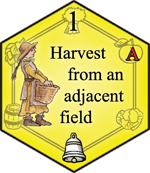 A.
A. A player
may harvest an extra crop counter of the type available from an adjacent unharvested field tile by
playing the
apprentice tile. The unharvested field tile is not turned over as a result of this extra harvest.
A player may still play this tile next to a harvested field, but if they do the player does not receive a crop counter.
1
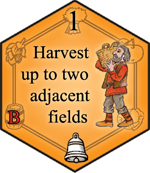 B.
B. A player
may harvest an extra crop counter of the type available from up to two adjacent unharvested field
tiles by playing the
casual worker tile. The unharvested field tiles are not turned over as a result of this
extra harvest. A player may still play this tile next to harvested fields, but if they do the player does not receive
a crop counter from those fields.
1
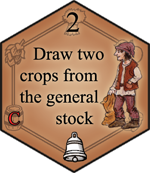 C.
C. A player
may draw any two crop counters from the general stock by playing the
labourer tile. They
should show the crop counters drawn to their opponents.
2
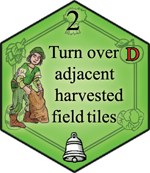 D.
D. A player
may turn over any adjacent harvested field tiles by playing the
unskilled worker tile.
2
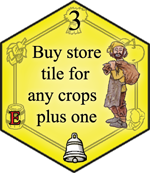 E.
E. Using the
skilled worker tile a player
may buy a tile from any opponent's store by paying one more crop
counter than the number of crop counters placed by the field tile - but the crop counters can be of any type.
3
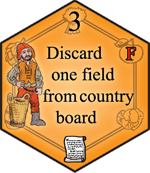
F. Using the supervisor tile a player must place one field tile from their country board into the fallow
fields' area. This can be one of the three or more tiles that are adjacent to the supervisor tile when played. 3
Note: The supervisor can be useful if a player is trying to split one large
group of connected field tiles into two smaller groups for scoring purposes
or simply to acquire three additional points at the end of the game.
Townsfolk
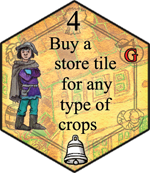 G.
G. Using the
merchant tile, a player
may buy a tile from any opponent's store using the correct number of crop
counters - but the crop counters can be of any type.
4
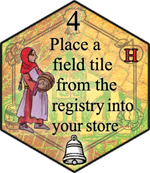
H. With the storekeeper tile, a player may place one field tile from the registry into their store (unless
there are already two there, which is the maximum number of field tiles they can have in their store) and place a bid
next to this tile. If a player does not have any crop counters or there is no room in their store for another field
tile then they may still place the storekeeper tile onto their country board, but they cannot place a field tile into
their store. Replace the field tile with a field tile from the bag. ** 4
Hint: If a player plays the storekeeper tile as their first action,
then they could place just one crop counter next to the field tile they are
placing in their store. In their second action they could then place the field
tile onto their country board, obtaining the field tile at the minimum cost.
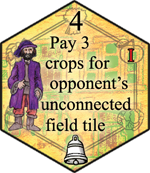
I. A player may take one unconnected field tile from another player's country board by using the baliff tile.
If they do so they must pay the other player three crop counters in compensation. 4
Note: Sometimes a player can take an unconnected field tile with the
same location reference as the space into which they have just
played the baliff tile. If they do so, then they must replace the baliff tile
with the field tile. As usual, when a worker tile is replaced with a field tile
and the worker tile can be repositioned in accordance with the
number of connections it requires, the player can use the worker (in this
case the baliff) tile again. Occasionally it is possible to repeat
this sequence more than once!
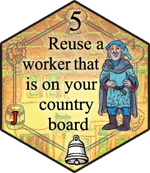 J.
J. With the
lawyer tile, a player
may reuse the skill of a worker which is on their country board. The reused
worker tile is not repositioned.
5
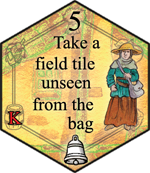
K. A player may take one tile unseen from the bag with the trader tile. A player may choose to place this field
tile on their country board or discard it to the fallow fields' area. If a player draws an event tile, they should announce
which tile it is to the other players and then replace the event tile back into the bag after a field tile has been successfully
drawn.
In the unusual event that there are no more field tiles in the bag, then
the player may instead take one of the face-up tiles from registry. 5
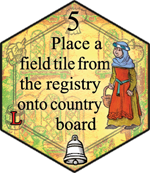 L.
L. With the
benefactor tile, a player
may place one field tile from the registry onto their country board.
Replace the field tile with a field tile from the cloth bag. **
5
** If when drawing a field tile from the bag as the result of the actions
required by a worker tile a player draws an event tile, then the event
tile is played in the normal way.
The text on the event tiles is limited by the space available. Each event
tile has a letter at the top. The letter is to cross reference the event tile
with the detailed rules below. At the bottom of each tile there is either a
bell or a scroll. The bell heralds events that are optional. Each player
may choose whether to participate in the event. The scroll identifies
events that are mandatory. These events must be actioned.
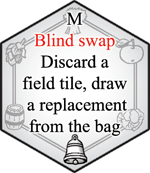
M. Blind swap. A player may choose to discard one field tile from their country board. If they do choose
to discard a field tile, the player should place the tile in the fallow fields' area and draw a replacement field tile
from the bag *. The player must place the replacement field tile onto their country board.
Players are warned that the replacement tile could displace a tonsfolk tile
that they cannot reposition, or that it could connect their two largest
groups of connected field tiles!
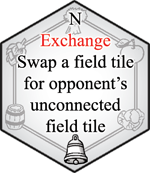 N. Exchange.
N. Exchange. If any other player has an unconnected field tile or tiles on their country board, a player
may
swap any one of their field tiles on their own country board for one of their opponents' unconnected field tiles.
The field tile that the player exchanges from their own country board does not need to be an unconnected field tile.
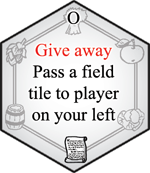
O. Give away. Each player must select one field tile and pass it to the player on their left. The tile selected
must either be on the player's country board or be the tile passed to them by the player on their right
(unless the player is the first player affected by this event tile who therefore does not receive a field tile from the
player on their right until after they have passed a tile to the player on their left). A player cannot pass on a field
tile from their store.
The player receiving the field tile may (i) put the field tile onto their country board so that the unharvested, large crop
symbol side is face up, (ii) pass the field tile to the player on their left (unless they are the last player affected by
this event tile) or (iii) discard the field tile and place it into the fallow fields area.
Note that a player may wish to discard the field tile if they are the last
person to receive a field tile and (i) the field tile was for a space occupied
by a worker tile on their country board that could not be replaced elsewhere
or (ii) the field tile would join their two largest groups of connected tiles.
Note that if a field tile is received for a location where the player already has
a worker tile (and the player decides to keep the field tile) and the worker
tile can be repositioned, then as the worker tile is being replaced by a field
tile the player gains the benefit of the worker tile again in the usual way.
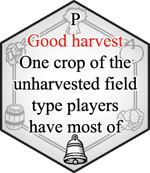 P. Good harvest.
P. Good harvest. Players
may immediately harvest one crop counter from the type of un-harvested field tile
that they have most of on their country board. If they have equal most of two or more types of field tile, then they may
choose any one of these types. If there are no crop counters of the correct type remaining in the general stock, then the
player may choose any remaining crop counter. Players should show the other players which type of crop counter they have
taken. The player does
not have to turn over the unharvested field tile as a result of the 'good harvest' however,
if a player has no unharvested tiles, then they do not get a crop counter.
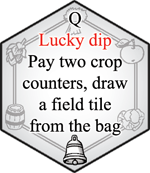 Q. Lucky dip.
Q. Lucky dip. Each player
may pay two crop counters of any type and draw a field tile from the bag. Each
player should show the crop counters they have paid to the other players. Players must immediately place the field tile
onto their country board. If there are no remaining field tiles in the bag, then a player may instead purchase one of the
face-up field tiles from the registry, if there are any available. (See also the warning given under 'blind swap' above.)
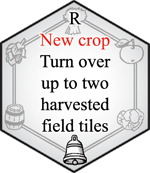 R. New crop.
R. New crop. Players
may turn over up to two harvested field tiles on their country board.
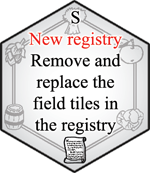 S. New registry.
S. New registry. The player drawing this tile
must first remove the tiles in the registry and place these
back in the bag. Secondly, they
must then draw replacement field tiles from the cloth bag.
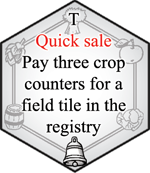 T. Quick sale.
T. Quick sale. Each player
may place three crop counters into the general stock. In return they take a field
tile from the registry and place this onto their country board. Replenish the registry from the bag* only after all of the
players who wish to buy a field tile have done so.
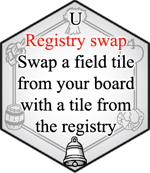 U. Registry swap.
U. Registry swap. Players
may swap a field tile from their country board with one of the field tiles in the
registry. Note that there are only likely to be five tiles available because this event tile would have been drawn as a
replacement for the sixth field tile in the registry.
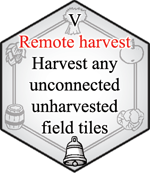 V. Remote harvest.
V. Remote harvest. Players
may harvest any unconnected unharvested field tiles.
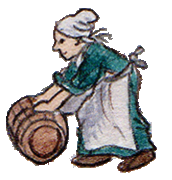
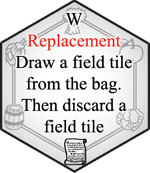 W. Replacement.
W. Replacement. Each player
must draw a field tile from the bag*. They may place the tile on their country
board if they discard a field tile already on their country board. Whichever field tile the player chooses not to keep
is placed in the fallow fields' area.
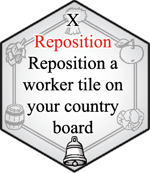
X. Reposition. A player may reposition one worker tile on their country board into another location. The
new location must have the required number of adjacent field tiles for that worker tile to be correctly placed. The worker
can displace a lower numbered worker in the usual way. The repositioned tile is not reactivated by the repositioning.
Hint: Players should see whether they can reposition a worker tile onto a
space where they can subsequently place a field tile. This will enable them
to gain the benefit of the worker tile again. This event may also help a
player to create new positions for subsequent worker tiles to be placed,
bearing in mind that two worker tiles cannot be placed next to each other.
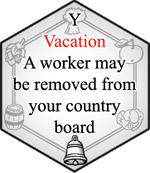 Y. Vacation.
Y. Vacation. A player
may remove one of their worker counters from their country board. The worker tile
is placed with the other unplayed worker tiles (if any) by the side of their country board or on the town board if it is
a townsfolk tile. The worker tile may be replayed later in the game.
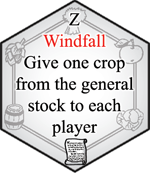 Z. Windfall.
Z. Windfall. The player drawing this tile (only)
must give one crop counter of their choice from the general
stock to each player in the game, including themselves.
* If, when drawing a field tile from the bag as the result of the actions
required by an event tile a player draws another event tile, they should
announce which event tile it is to the other players and then place the event
tile to one side. Then, after a field tile has been successfully drawn, the
event tile(s) that were placed to one side are placed back into the bag.

At the beginning of the game a player starts with two tiles on different sides
of their country board. If the opportunity arises in the early part of
the game to buy other tiles cheaply, even if they are not close to the player's
starting tiles, it is usually beneficial to do so. All tiles are useful. They can
be the start of new groups of fields, or tiles to give away or sacrifice (in
response to the event tiles). A player should try to avoid obtaining all of
their field tiles in just one corner of their country board as this will restrict
their opportunities to expand. If a player spreads out, most tiles will be
of interest to them and they may well be able to link groups of field tiles
later in the game.
Suggested actions for the first turn in the game: First, use action (b) to
place the apprentice tile to next to a field tile (if possible in a location
where there is a field tile available in the registry) in order to obtain an
extra crop counter. Secondly, use action (d) to take two field tiles from
the registry and to place these into the store.
Think carefully before sacrificing one of your two starting field tiles (in
response to the event tiles) as these are strategically placed away from
the player's opponent's starting tiles and provide an interest to the player
on both sides of their country board.
The game is likely to be won by the player who (i) best prices the field
tiles they want to keep and to attract counter bids for and (ii)
makes the best use and reuse of their workers, in particular getting
free extra usage of their workers by playing worker tiles on fields where
they subsequently obtain field tiles.
If a player can place a worker tile in a location where they are about to
place a field tile from a store - see action (d), then the player will be
able to use the action described on the worker tile again for 'free' -
assuming there is another position that they can place the worker tile.
If a player leaves one or two of the field tiles in their store from their
previous turn, then this may restrict the number of field tiles they can
place in their store in their following turn.
Note that it is likely that not all of the field tiles will become available to
each player. Some of the field tiles may be discarded, or only become
available to other players, as a result of the event tiles and some of the
field tiles may not be drawn from the bag (as the game end phase begins
once a tenth event tile is drawn and placed on the town board). Players
should bear this in mind when they are devloping their strategy.
The player area:
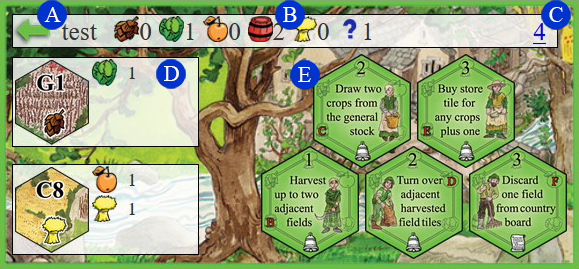
 If you click this arrow, the country board display will switch to showing this player's country board.
If you click this arrow, the country board display will switch to showing this player's country board.
 This shows the resources that the player holds. In the beginning of a three or four player game, each player
draws a few secret resources. The question mark icon tracks these resources while you still don't know their
crop type.
This shows the resources that the player holds. In the beginning of a three or four player game, each player
draws a few secret resources. The question mark icon tracks these resources while you still don't know their
crop type.
 This is the total points earned by the player so far. Click on this number to show more details about
how this total is calculated.
This is the total points earned by the player so far. Click on this number to show more details about
how this total is calculated.
 This part of the player area shows the field tiles that the player has offered for sale, and the corresponding
bid for each tile.
This part of the player area shows the field tiles that the player has offered for sale, and the corresponding
bid for each tile.
 This shows the player's farmhands that have not been placed in the field yet.
This shows the player's farmhands that have not been placed in the field yet.
The town board:

 This is the registry -- the six tiles available to offer for sale.
This is the registry -- the six tiles available to offer for sale.
 This shows how many events have happened so far. Since 10 events ends the game, this gives a quick
view of how much of the game is left to be played. If you click on this area, you will see which
events have happened.
This shows how many events have happened so far. Since 10 events ends the game, this gives a quick
view of how much of the game is left to be played. If you click on this area, you will see which
events have happened.
 There is a limited supply of each crop counter in the game. This area shows how many crop counters
of each type are still available.
There is a limited supply of each crop counter in the game. This area shows how many crop counters
of each type are still available.
 This shows how many fields are fallow (i.e. will never again be available in the game). Click on
this area to see details about which fields have become fallow.
This shows how many fields are fallow (i.e. will never again be available in the game). Click on
this area to see details about which fields have become fallow.
 This shows the townsfolk that are still available.
This shows the townsfolk that are still available.
If you need help distinguishing between the filled and empty hexagons on the board, you can enable
the "Show field outlines" option (under the heart tab).
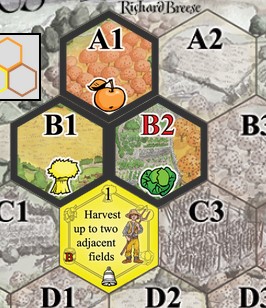

Once the tenth event is drawn, the end of the game is near. When that
happens, the events area will turn yellow as shown above.
You can click on this area and the town board is replaced by a view that
shows the events that have happened as usual. But now, that view also shows
details about the remaining turns in the game (see below). Each row in this
table is one round, and the yellow highlighted cell is the player currently
on turn.
